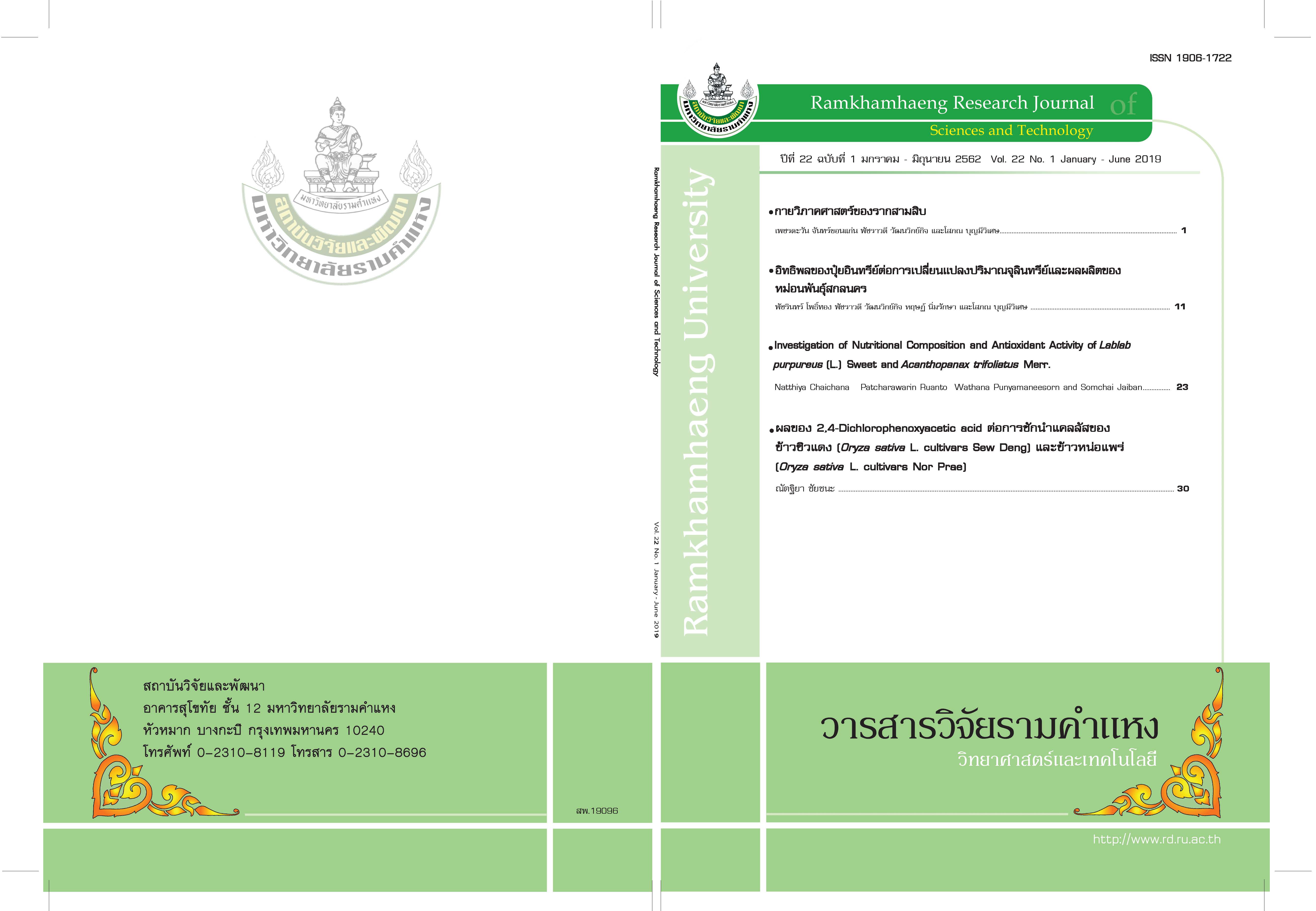Investigation of nutritional composition and antioxidant activity of Lablab purpureus (L.) Sweet and Acanthopanax trifoliatus Merr.
Main Article Content
Abstract
This research was purposed to investigate nutritional composition and antioxidant activity of Lablab purpureus (L.) Sweet and Acanthopanax trifoliatus Merr., the useful local plants in Chiang Rai. Nutritional analysis was based on Association of Official Analytical Chemists (AOAC) method. The result revealed that both plants contained fat, protein, carbohydrates, crude fiber and ash in ranges of 1.98 - 3.56, 20.77 - 26.15, 37.37 - 50.53, 10.77 - 22.75 and 6.49 - 9.93 g per 100 g DW, respectively. Moreover, both plants also provided different ratios of 12 minerals (N, P, K, Ca, Mg, Mn, S, B, Na, Fe, Zn and Cu). For antioxidant and total phenolic analysis, it was found that A. trifoliatus Merr. represented antioxidant activity with the value of 26.81 µmol TE/g and phenolic content with the value of 9.42 mgGE/g higher L. purpureus (L.) Sweet
Article Details
Ramkhamhaeng University
References
Ahmad, B., Abbas, S.J., Hussain, F., Bashir, S. and Ahmad, D. 2014. Study on Caralluma Tuberculata nutritional composition and its importance as medicinal plant. Pakistan Journal of Botany. 46(5): 1677-1684.
Akubugwo, I.E., Obasi, N.A., Chinyere, G.C. and Ugbogu, A. E. 2007. Nutritional and chemical value of Amaranthus hybridus L. leaves from Afikpo, Nigeria. African Journal of Biotechnology. 6(24): 2833-2839.
Association of Official Analytical Chemists (AOAC). 2000.Official Methods of Analysis of AOAC International. 17th ed. Gaithersburg. AOAC International.
Bahadur, A., Chaudhry, Z., Jan, G., Danish, M., Rehman, A., Ahmad, R., Khan, A., Khalid, S., Ullah, I., Shah, Z., Ali, F., Mushtaq, T. and Jan, F.G. 2011. Nutritional and elemental analyses of some selected fodder species used in traditional medicine. African Journal of Pharmacy and Pharmacology. 5(8): 1157-1161.
Brand-Williams, W., Cuvelier, M.E. and Berset, C. 1995. Use of a free radical method to evaluate antioxidant activity. LWT Food Science and Technology. 28(1): 25-30.
Grivetti, L.E. and Ogle, B.M. 2000. Value of traditional foods in meeting macro- and micronutrient needs: the wild plant connection. Nutrition Research Reviews. 13(1): 31-46.
Hossain, M.A. and Shah, M.D. 2015. A study on the total phenols content and antioxidant activity of essential oil and different solvent extracts of endemic plant Merremia borneensis. Arabian Journal of Chemistry. 8: 66-71.
Khan, N., Sultana, A., Tahir, N. and Jamila, N. 2013. Nutritional composition, vitamins, minerals and toxic heavy metals analysis of Trianthema portulacastrum L., a wild edible plant from Peshawar, Khyber Pakhtunkhwa, Pakistan. African Journal of Biotechnology. 12(42): 6079-6085.
Konczak, I., Zabaras, D., Dunstan, M. and Aguas, P. 2010. Antioxidant capacity and phenolic compounds in commercially grown native Australian herbs and spices. Food Chemistry. 122: 260-266.
Lu, M., Yuan, B., Zeng, M. and Chen, J. 2011. Antioxidant capacity and major phenolic compounds of spices commonly consumed in China. Food Research International. 44: 530-536.
Mamiro, P.S., Mbwaga, A.M., Mamiro, D.P., Mwanri, A.W. and Kinabo, J.L. 2011. Nutritional quality and utilization of local and improved cowpea varieties in some regions in Tanzania. African Journal of Food, Agriculture, Nutrition and Development. 11(1): 4490-4506.
Mariga, I.K., Lutendo, M. and Maposa, D. 2012. Nutritional assessment of a traditional local vegetable (Brassica oleracea var. acephala). Journal of Medicinal Plants Research. 6(5): 784-789.
Miliauskasa, G., Venskutonisa, P.R. and Beek, T.A. 2004. Screening of radical scavenging activity of some medicinal and aromatic plant extracts. Food Chemistry. 85: 231-237.
Payum, T., Das, A.K, and Shankar, R. 2015. Phytochemistry, pharmacognosy and nutritional composition of Allium Hookeri: an ethnic food plant used among Adi tribe of Arunachal Pradesh, India. American Journal of PharmTech Research. 5(1): 464-477.
Roby, M.H.H., Sarhan, M.A., Selim, K.A.H., and Khalel, K.I. 2013. Evaluation of antioxidant activity, total phenols and phenolic compounds in thyme (Thymus vulgaris L.), sage (Salvia officinalis L.), and marjoram (Origanum majorana L.) extracts. Industrial Crops and Products. 43: 827- 831.
Saha, D., Sundriyal, M. and Sundriyal, R.C. 2014. Diversity of food composition and nutritive analysis of edible wild plants in a multi-ethnic tribal land, Northeast India: an important facet for food supply. Indian Journal of Traditional Knowledge. 13(4): 698-705.
Srianta, I., Arisasmita, J.H., Patria, H.D. and Epriliati, I. 2012. Ethnobotany, nutritional composition and DPPH radical scavenging of leafy vegetables of wild Paederia foetida and Erechtites hieracifolia. International Food Research Journal. 19(1): 245-250.


